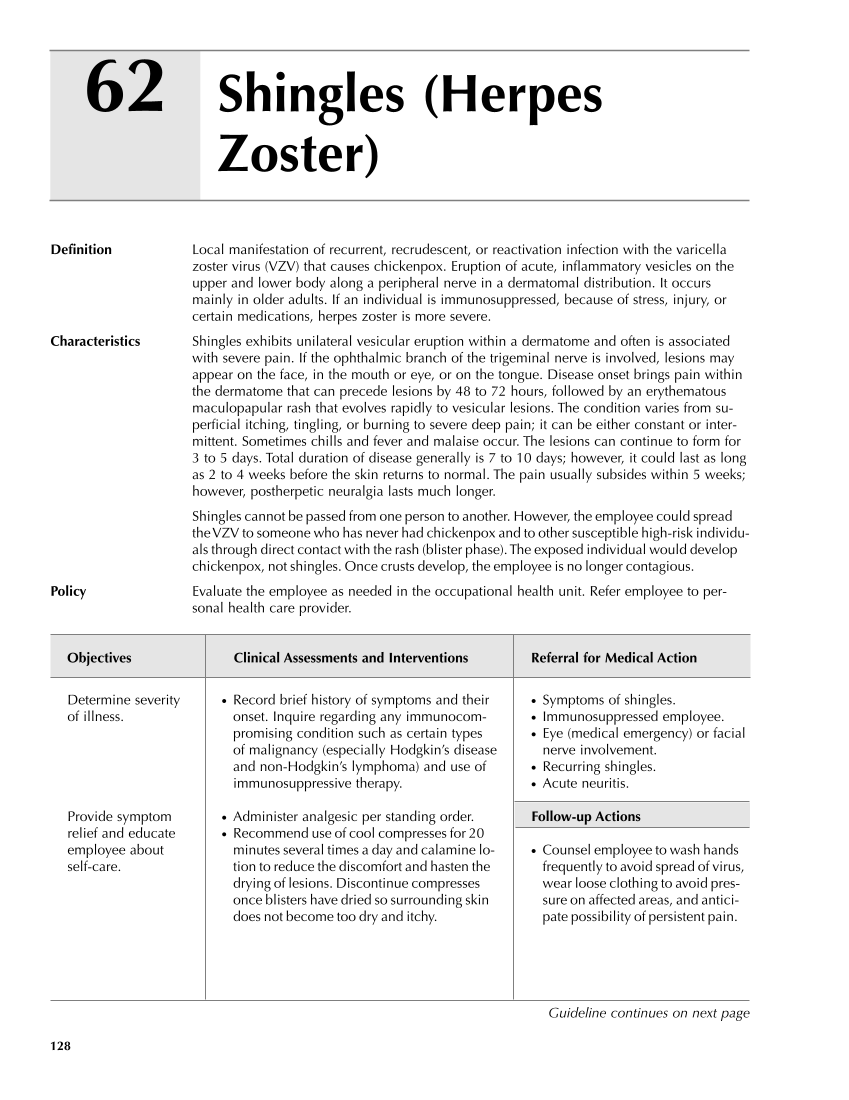62 128 Definition Local manifestation of recurrent, recrudescent, or reactivation infection with the varicella zoster virus (VZV) that causes chickenpox. Eruption of acute, inflammatory vesicles on the upper and lower body along a peripheral nerve in a dermatomal distribution. It occurs mainly in older adults. If an individual is immunosuppressed, because of stress, injury, or certain medications, herpes zoster is more severe. Characteristics Shingles exhibits unilateral vesicular eruption within a dermatome and often is associated with severe pain. If the ophthalmic branch of the trigeminal nerve is involved, lesions may appear on the face, in the mouth or eye, or on the tongue. Disease onset brings pain within the dermatome that can precede lesions by 48 to 72 hours, followed by an erythematous maculopapular rash that evolves rapidly to vesicular lesions. The condition varies from su- perficial itching, tingling, or burning to severe deep pain it can be either constant or inter- mittent. Sometimes chills and fever and malaise occur. The lesions can continue to form for 3 to 5 days. Total duration of disease generally is 7 to 10 days however, it could last as long as 2 to 4 weeks before the skin returns to normal. The pain usually subsides within 5 weeks however, postherpetic neuralgia lasts much longer. Shingles cannot be passed from one person to another. However, the employee could spread the VZV to someone who has never had chickenpox and to other susceptible high-risk individu- als through direct contact with the rash (blister phase). The exposed individual would develop chickenpox, not shingles. Once crusts develop, the employee is no longer contagious. Policy Evaluate the employee as needed in the occupational health unit. Refer employee to per- sonal health care provider. Objectives Clinical Assessments and Interventions Referral for Medical Action Shingles (Herpes Zoster) ● Symptoms of shingles. ● Immunosuppressed employee. ● Eye (medical emergency) or facial nerve involvement. ● Recurring shingles. ● Acute neuritis. Follow-up Actions ● Counsel employee to wash hands frequently to avoid spread of virus, wear loose clothing to avoid pres- sure on affected areas, and antici- pate possibility of persistent pain. Determine severity of illness. Provide symptom relief and educate employee about self-care. ● Record brief history of symptoms and their onset. Inquire regarding any immunocom- promising condition such as certain types of malignancy (especially Hodgkin’s disease and non-Hodgkin’s lymphoma) and use of immunosuppressive therapy. ● Administer analgesic per standing order. ● Recommend use of cool compresses for 20 minutes several times a day and calamine lo- tion to reduce the discomfort and hasten the drying of lesions. Discontinue compresses once blisters have dried so surrounding skin does not become too dry and itchy. Guideline continues on next page
Purchased from OEM Press by (ge corporate access). (C) 2013 OEM Health Information, Inc. All rights reserved.












































































































































































































































































































































































































































